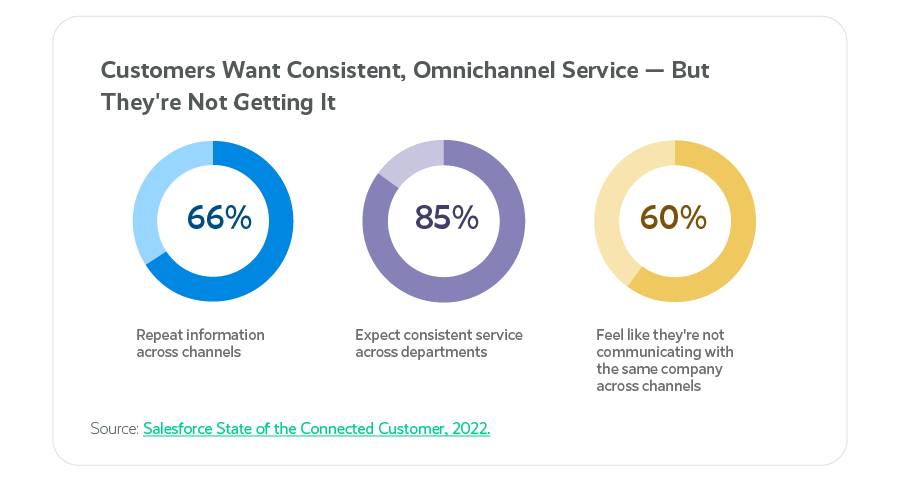6 Mistakes Hurting Your First Contact Resolution Metrics — And How To Solve Them
Wondering how to measure your First Contact Resolution metric and what it means for your contact center? First Contact Resolution (FCR) is a crucial key performance indicator (KPI) for establishing customer satisfaction and operational performance.
Alongside Net Promoter Score, First Contact Resolution metrics reveal how effectively your customer service agents are resolving clients’ issues the first time around without customers having to reach out again regarding the same issue or being passed around to try to resolve an inquiry.

What Is First Contact Resolution (FCR)?
First Contact Resolution, also known as First Call Resolution, is exactly what it sounds like: solving customer issues the first time they get in touch with your support center. When a customer’s inquiry is solved on first contact, it saves time and money — and builds trust in your organization.
Why Is FCR An Important Metric?
Increasing your First Contact Resolution rate may seem complex and difficult to achieve, but making small, iterative improvements has a major impact on the customer experience, retention, and revenue. It also has a big impact on agent engagement and satisfaction because a high FCR rate means less repeat work for your employees.
Related Article: 6 Strategies To Improve First Contact Resolution
How To Calculate First Contact Resolution
The key to measuring your First Contact Resolution metric is to first answer specific questions that help you define and calculate your FCR rate. Once you have your FCR metric established, you can compare it to the industry standard.
In most cases, a post-call survey is used as a tool for First Call Resolution measurement. It is also common for agents to ask a customer if they resolved their issue. The phone and email survey methods use a standardized measurement methodology so you can compare the First Contact Resolution metrics against other contact centers.
To calculate your FCR rate, you need to know:
- The total number of interactions with customers
- The number of issues resolved in one customer interaction
Then, simply divide the number of contacts resolved the first time by the total contacts and multiply by 100.
For example, if you make 100 customer contacts in a day and 70 of them are resolved in one touch and 30 are follow-up interactions from previous issues, your FCR rate would be 70%.
A good FCR rate will vary widely depending on many factors, the Association for Support Professionals reports. Factors like product type, complexity, price, and defect rate all will have an impact on your FCR and might make it harder for your agents to resolve an issue on a first customer call or ticket.
What’s Hurting Your First Contact Resolution Metrics
Here are six mistakes that hurt your First Contact Resolution metric and our recommendations to solve them.
1. Extended Hold Times
Challenge: Customers appreciate fast service and getting through to an agent without waiting on hold. This makes sense since we all just want to be heard, of course. And we’ve all felt the frustration of being forced to wait on hold for minutes or even hours while trying to resolve an important issue.
If customer service agents are not sure of an answer and need to do research, they have to keep customers waiting. Keeping a customer on hold for too long can, unfortunately, lead to a call being disconnected or a customer getting impatient and hanging up.
What’s next? The customer is forced to call back, which impacts your First Contact Resolution metrics. The same holds true in the age of bots and automated assistants. If an automated bot asks a customer if they can help and then doesn’t respond promptly, the customer will leave the interaction frustrated.
Solution: To decrease customer wait times and improve customer satisfaction, answers should be readily available and accessible for customer service agents. Something as simple as an employee forum can organize responses to FAQs, minimize hold times, and positively impact the customer experience.
An employee forum can be broken down into two parts. The first part can be an FAQ section created by your company, providing answers to common customer service questions.
The second part can allow agents to ask questions while supervisors or managers provide answers that are visible for the entire team to see and refer to as needed. This empowers agents to deliver what customers need and saves managers’ time because they aren’t answering the same question time and time again. You can also leverage tools such as ChatGPT or AI in order to automate answering commonly asked questions.
Another helpful tool to consider: Give your customer service staff access to First Contact Resolution coaching and training sessions in a digestible format like video. It’s normal to forget, and giving customer service agents access to past lessons allows them to brush up when they feel a subject needs to be refreshed to bolster contact center metrics.
Related Content: 9 Contact Center Metrics Essential for Success
2. Transferring Customers
Challenge: Customers tend to get annoyed if they get transferred from agent to agent. Who hasn’t felt that frustration? Your organization’s First Contact Resolution metrics could be negatively impacted as a result of too many transfers.
Customers could be getting transferred around because there are too many extensions to choose from. With too many options, it’s easy for customers to become confused and press any random number just to speak with an agent, only to land with the wrong department and decrease opportunities for First Contact Resolution.
Another common issue: If contact center team members haven’t been trained properly, they won’t know how to resolve customer requests and the customer will continue to bounce around from department to department. Situations like this are painful for customers and agents.
Transferring a customer from one department to the next leaves space to be disconnected, forcing customers to call back and lowering First Contact Resolution rates in your contact center.
Solution: One First Contact Resolution action strategy is to review your IVR. Start by testing the process to see how easy it is to meet customer expectations and land in the correct department. The First Contact Resolution system may need to be reviewed, simplified, or expanded upon.
If a customer gets transferred around from one agent to the next within the same department, the cause may be a lack of training.
Be sure to not only provide proper onboarding training but also engage agents in ongoing learning sessions. Playvox features training for managers to create learning material, test the user’s knowledge, and provide feedback on an ongoing basis.
Related Article: How To Identify And Address Call Avoidance
3. Agents Feeling Stuck
Challenge: Onboarding and First Contact Resolution training can be hectic for a new team member. There are a lot of new things to learn. In the midst of it all, it can be easy to forget what to do. So in the beginning, it’s normal for an agent to feel stuck while working with a customer on initial contact, whether by phone, email, social media, or chat session.
Feeling stuck and having an elevated Average Handle Time is a typical part of onboarding in those first few weeks, but the customer won’t know they’ve connected with a new team member. So there’s a risk of not only low First Contact Resolution but also a negative customer experience.
Solution: In this case, there are several good solutions to include in a First Contact Resolution action plan. The simplest first step is to escalate the contact. Shifting the conversation to an agent with more experience can be helpful for the customer, but it’s not a good long-term response.
An ideal solution to lower response time should include empowering every level of your contact center staff. Provide the tools they need to figure things out on their own. Give them the power to make decisions and improvements in customer satisfaction.
Related Article: Five Coaching Tips For Contact Center Agents that Work
4. Poor Or Non-Existent CRM System
Challenge: Spreadsheets are a thing of the past. Storing crucial customer information on shared spreadsheets can lead to incomplete, incorrect, and missing information. Not to mention that storing customer information in decentralized files is also a severe security risk for your company.
Even the best spreadsheets are cumbersome to use and make sharing details a challenge. Especially when an agent is navigating a customer service issue, searching a spreadsheet for crucial details is far from ideal and hurts employee satisfaction.
Without a proper CRM system, your organization doesn’t have a full record of your customers’ demographics, insights into the touch points they’ve had with your company, customer history, or a quick understanding of the issues they are facing.
First Contact Resolution metric improvements are difficult to achieve without a CRM. An agent has to assist a customer from scratch every time they reach out, which becomes a waste of time on both ends and is frustrating for a customer to have to repeat themselves constantly. An omnichannel approach to CX is virtually impossible without a CRM.

Solution: Proving First Call Resolution rate improvements takes time. It’s an investment. Research and select a CRM system that works for your organization. Not only will a CRM ultimately save time and provide your company with valuable information, but your agents will be able to anticipate your customers’ demands with the wealth of information that you have. This is an important part of laying the foundation for a great customer experience and employee satisfaction.
Related Article: The Top 4 Contact Center Trends To Boost Performance And CX
5. Not Optimizing Staff
Challenge: Knowing that positive First Contact Resolution metrics keep customers satisfied with your company, you must have the best customer service agents on the front lines. When your staff isn’t optimized, your contact center isn’t prepared to deliver excellence in a single interaction. It’s that simple.
Staff inefficiencies leave room for error in your contact center. You may have too many agents working during quiet times and too few during busy times. You may have a mismatch of the talent you need for the calls you receive. Performance may not be fine-tuned. These are only a few mistakes that can cause First Contact Resolution metrics to suffer.
Solution: Another First Contact Resolution tip is to have a dashboard that allows you to see how your customer service agents are performing with metrics over a period of time and in real time. This helps you identify each agent’s performance.
Playvox’s Workforce Management solution does just that, allowing you to plan, forecast, schedule, set metrics, view staff performance, and coach accordingly. With a dashboard, success isn’t left to chance. You can monitor, adjust, and improve with the right data points on hand.
Related Article: Can Your WFM Solution Accurately Forecast In A Modern Digital Contact Center?
6. Outdated First Contact Resolution Training
Challenge: Even if you think your customer service agents are doing well, there’s always room for improvement. Continuously working toward better First Contact Resolution metrics should be a primary goal for your customer service team.
Agents who have been with your organization for a year or more can benefit from new training to refresh old skills and increase their expertise with new best practices, but not if training content is outdated. And if you want your newest contact center agents to thrive from day one, you can’t expect success with old or irrelevant training material.
Solution: Improving First Contact Resolution can happen with ongoing coaching and training. Unlike onboarding, training is not a one-off that happens just at the beginning of an agent’s time with your organization. Training and coaching on First Contact Resolution should be done regularly for vital information to sink in, for new information to surface, and for any questions or issues to be addressed.
Great training doesn’t have to stop at remedying First Contact Resolution metrics. Training for contact center agents can help to improve quality, behavior, compliance, soft skills, customer experience, and much more.
Solve Customer Problems The First Time For Better Retention
Measuring First Contact Resolution metrics is the first step in ensuring your customers are happy and satisfied with the quality of service your agents offer. These six strategies lay the foundation to transform your contact center and drive customer retention.
Interested in learning more or exploring how Playvox could help you improve your contact center? Request a demo today.





